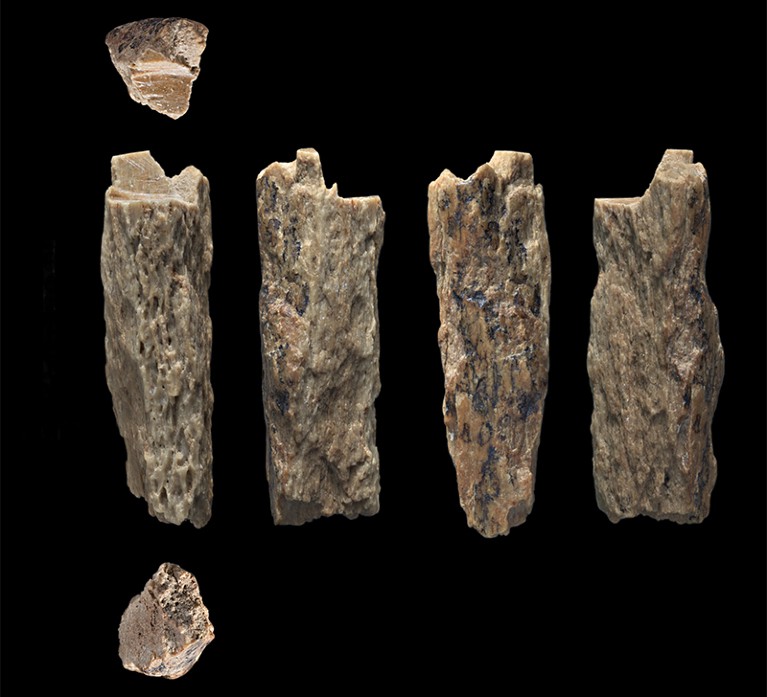
Bone fragments that represent the daughter of a Neanderthal mother and a Denisovan fatherCredit: Thomas Higham, University of Oxford
Roughly 90,000 years ago, a Neanderthal female mated with a Denisovan male and gave birth to a daughter — the earliest known offspring of two distinct hominin groups. The researchers who sequenced her genome from a bone fragment found in a cave announced the discovery in August 2018 (V. Slon et al. Nature 561, 113–116; 2018).
Scientists knew from DNA evidence that the two extinct groups of humans must have interbred, but they had never found a first-generation offspring before. The closest they had come was finding a Homo sapiens specimen that had Neanderthal ancestry from four to six generations previously.
Viviane Slon and Svante Pääbo, palaeogeneticists at the Max Planck Institute for Evolutionary Anthropology in Leipzig, Germany, were part of the team that made the hybrid DNA discovery, which provides new insights into the lives of ancient hominins. “It tells us that these groups interacted more than we thought,” says Slon, who earned her PhD at the institute and is the first author on the paper.
Ancient DNA
A team from the Russian Academy of Sciences excavated the bones from a cave in the Altai Mountains of Russia, and researchers from the University of Oxford and University of Manchester in the United Kingdom used mass spectroscopy to examine the remains for signs of human proteins. They were then passed to Slon and Pääbo’s institute for DNA sequencing. Pääbo has been working with the Russian Academy for a long time, Slon says, and his lab has developed techniques to deal with the special challenges of ancient DNA, which degrades over time and has gone through certain chemical modifications. In addition to its department of evolutionary genetics, where Slon and Pääbo are based, the institute has departments of primatology, of human evolution and of human behaviour, ecology and culture, and interdepartmental collaborations have helped scientists to piece together pictures of ancient humans from different lines of evidence. “You can tackle questions from different angles, so I think that’s why the institute is quite well known,” Slon says.
Slon, who earned her bachelor’s and master’s degrees at the University of Tel Aviv in Israel, says she applied to do her doctoral studies in Leipzig specifically because she wanted to work with Pääbo, who is Swedish. She says that the institute is international in nature, with researchers from many countries, and gives her the freedom to pursue her interests as well as travel to conferences and anthropological sites. Although Slon doesn’t speak German, she notes that this hasn’t caused many difficulties and that the institute has given her help with various tasks, such as finding an apartment. “There’s a lot of people here who help out for the research but also for your personal life, even if you don’t speak the language.”


 Career Guide: Germany
Career Guide: Germany
 An introduction to the complexities of the German research scene
An introduction to the complexities of the German research scene
 How Germany is winning at turning its research to commercial application
How Germany is winning at turning its research to commercial application
 Ten reasons to move to Germany as a researcher
Ten reasons to move to Germany as a researcher
 The science of starting a new life
The science of starting a new life
 British chemist battles xenophobia in Germany
British chemist battles xenophobia in Germany
 Germany faces its future as a pioneer in sustainability and renewable energy
Germany faces its future as a pioneer in sustainability and renewable energy
 The second coming of solar
The second coming of solar
 Ten research collaborations between Germany and the rest of the world
Ten research collaborations between Germany and the rest of the world
 Sexism is still a problem for German research
Sexism is still a problem for German research
 Preceded by 967 men: meet the first woman in charge of the 600-year-old Leipzig University
Preceded by 967 men: meet the first woman in charge of the 600-year-old Leipzig University
 Germany’s attitude to start-up firms is undergoing profound change
Germany’s attitude to start-up firms is undergoing profound change
 No more career headaches
No more career headaches








